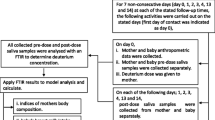Abstract
Maternal guinea pigs were injected with mercuric chloride (HgCl2; 1 mg Hg/kg body weight) or methylmercury (MeHg; 1 mg Hg/kg) 12 h after parturition, and exposure of the offspring to mercury (Hg) via breast milk were studied on days 3, 5 and 10 postpartum. Milk Hg concentrations were lower than maternal plasma Hg concentrations regardless of the form of Hg given to the dams. Milk Hg was higher in HgCl2-treated dams than in MeHg-treated dams. In MeHg-treated dams, MeHg was separately determined. While the ratio of MeHg to T-Hg decreased in the dams’ plasma, it did not in the milk. There was a strong correlation between milk and plasma T-Hg concentrations in HgCl2 treated dams. In the milk of MeHg-treated dams, the plasma MeHg concentrations correlated better than did the plasma T-Hg concentrations. In the offspring, regardless of the chemical forms of Hg given to the dams, the highest Hg concentrations were found in the kidney, followed by the liver and the brain. Brain Hg concentrations were, however, significantly higher in the offspring of MeHg-treated dams than in those of HgCl2-treated dams. In addition, Hg levels in the major organs of the offspring of HgCl2-treated dams peaked on day 5 postpartum, while those of MeHg-treated dams did not show a significant decrease up to day 10 postpartum. These facts indicate that the two chemical forms of Hg were transferred to the offspring via the breast milk and were distributed differently, depending on the chemical form, to the offspring’s tissues.
Similar content being viewed by others
References
Akagi H, Nishimura H (1991) Speciation of mercury in the environment. In: Suzuki T, Imura N, Clarkson TW (eds) Advances in mercury toxicology. Plenum, New York, pp. 53–76
Amin-Zaki L, Majeed LM, Greenwood MR, Elhassani SB, Clarkson TW, Doherty RA (1981) Methylmercury poisoning in the Iraqi suckling infant: a longitudinal study over five years. J App Toxicol 1: 210–214
Bakir F, Damluji SF, Amin-Zaki L, Murtadha M, Khalidi A, Al-Rawi NY, Tikriti S, Dhahir HI, Clarkson TW, Smith JC, Doherty RA (1973) Methylmercury poisoning in Iraq. Science 181: 230–241
Clarkson TW, Nordberg GF, Sanger PR (1985) Reproductive and developmental toxicity of metals. Scand J Work Environ Health 11: 145–154
Fujita M, Takabatake E (1977) Mercury levels in human maternal and neonatal blood, hair and milk. Bull Environ Contam Toxicol 18: 205–209
Koos BJ, Longo LD (1976) Mercury toxicity in the pregnant woman, fetus, and newborn infant. Am J Obstet Gynecol 126: 390–409
Mansour MM, Dyer NC, Hoffman LH, Schulert AR, Brill AB (1973) Maternal-fetal transfer of organic and inorganic mercury via placenta and milk Environ Res 6: 479–484
Rowland IR, Robinson RD, Doherty RA, Landry TD (1983) Are developmental changes in methylmercury metabolism and excretion mediated by the intestinal microflora. In: Clarkson TW, Nordberg GF, Sager PR (eds) Reproductive and developmental toxicity of metals. Plenum, New York, pp 745–758
Skerfving S (1988) Mercury in women exposed to methylmercury through fish consumption, and in their newborn babies and breast milk. Bull Environ Contam Toxicol 41: 475–485
Sundberg J, Oskarsson A (1992) Placental and lactational transfer of mercury from rats exposed to methylmercury in their diet: speciation of mercury in the offspring. J Trace Elem Exp Med 5: 47–56
Sundberg J, Oskarsson A, Albanus, L (1991a) Methylmercury exposure during lactation: milk concentration and tissue uptake of mercury in the neonatal rat. Bull Environ Contam Toxicol 46: 255–262
Sundberg J, Oskarsson A, Bergman K (1991b) Milk transfer of inorganic mercury to suckling rats: Interaction with selenite. Biol Trace Elem Res 28: 27–38
Vimy MJ, Takahashi Y, Lorscheider FL (1990) Maternal-fetal distribution of mercury (203Hg) released from dental amalgam fillings. Am Physiol Soc 258: R939-R945
WHO (1991) Environmental health criteria 118: Inorganic mercury. World Health Organization, Geneva
Yoshida M, Yamamura Y, Satoh H (1986) Distribution of mercury in guinea pig offspring after in utero exposure to mercury vapor during late gestation. Arch Toxicol 58: 225–228
Yoshida M, Satoh H, Kishimoto T, Yamamura Y (1992) Exposure to mercury via breast milk in suckling offspring of maternal guinea pigs exposed to mercury vapor after parturition. J Toxicol Environ Health 35: 135–139
Author information
Authors and Affiliations
Rights and permissions
About this article
Cite this article
Yoshida, M., Watanabe, C., Satoh, H. et al. Milk transfer and tissue uptake of mercury in suckling offspring after exposure of lactating maternal guinea pigs to inorganic or methylmercury. Arch Toxicol 68, 174–178 (1994). https://doi.org/10.1007/s002040050051
Received:
Accepted:
Issue Date:
DOI: https://doi.org/10.1007/s002040050051




